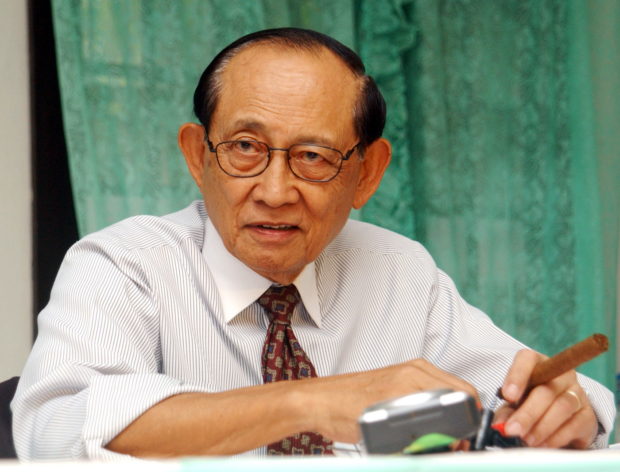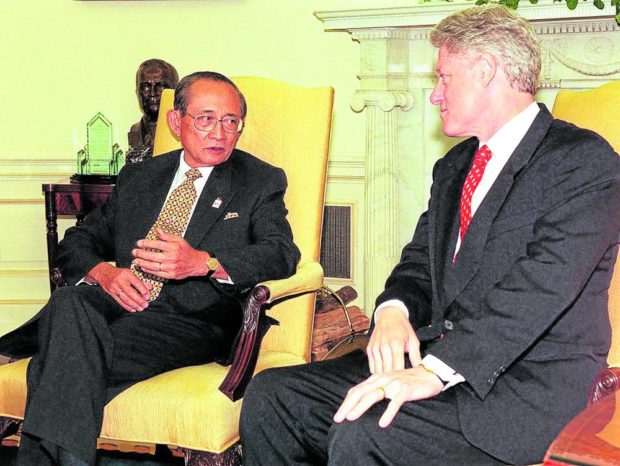Fidel V. Ramos, 94: Stabilizer in chief

ROLLED-UP SLEEVES AND A CIGAR | President Fidel V. Ramos knew the power of images. The late chief executive fondly called “Tabako” by friends and subordinates was often photographed with an unlit cigar. Many winced when he rolled up the sleeves of his barong tagalog — until they realized the gesture was meant to convey that he was serious about work. And of course, there was the optimistic thumbs up that he flashed whenever he said, “Kaya natin ’to (We can do this).” (INQUIRER FILE PHOTO)
MANILA, Philippines — The nation on Sunday mourned the passing of an esteemed military officer and public servant, Fidel V. Ramos, the country’s 12th President often commended as the best economic manager the Philippines ever had. He was 94.
“The Ramos family is profoundly saddened to announce the passing of former President Fidel Valdez Ramos,” read a brief official statement issued by the family. “We thank you all for respecting our privacy, as the family takes some time to grieve together.”
The family said wake and funeral arrangements would be announced in the near future.
Ramos was a celebrated military official, politician, and an Edsa hero who played a crucial role in restoring democracy in the Philippines during the 1986 People Power Revolution.
It was also during his presidency that the government and the Moro National Liberation Front (MNLF) signed a peace agreement in 1997. Together with MNLF chair Nur Misuari, Ramos was awarded the coveted 1997 Unesco Peace Prize—the first for Asians.
Article continues after this advertisementHe was married to Amelita Ramos and they had five daughters together.
Article continues after this advertisementRamos has often been credited for resuscitating the economy back to a desirable growth path and allowing the country to rid itself of the shameful reputation as “the sick man of Asia.’’
When the financial crisis of 1997 led many emerging economies in the region to the brink of collapse, foreign lenders and investment analysts predicted that the Philippines was likely to turn the corner earlier than its peers. Much of the credit for such optimism went to President Ramos, who stood out for successfully reviving the economy that was severely weakened by several coup attempts and political instability during the final years of the Aquino presidency.
Topping the myriad of problems he faced was an energy shortage, which he quickly resolved during his first year in office in 1992. In the succeeding years, Ramos focused on strengthening the economic structure such that by 1996, when the Philippines hosted the 18-nation Asia-Pacific Economic Cooperation (Apec) summit, the country’s economic recovery was the center of admiration and praise.
Liberalization push
Among his major accomplishments included the dismantling of monopolies and cartels in telecommunications, shipping and banking, and opening up the economy to foreign investors; deregulating water services and airlines and privatizing the Manila Waterworks and Sewerage System (MWSS) and Philippine Airlines, and steering the economy to an annual growth of 5 percent until 1997 to allow the country to finally exit supervision by the International Monetary Fund after 35 years.
The Ramos administration also saw the passage of the Comprehensive Tax Reform Program, which introduced progressive rather than regressive concepts of taxation, a reduction in the unemployment rate from 9.8 percent to 8.4 percent at the end of 1997, and an easing of poverty to 35 percent from 40 percent, with the per capita income increasing from $800 to $1,240 over the period 1992-97.

THE WORLD WAS HIS STAGE | This April 10, 1998, photo shows then Philippine President Fidel Ramos conferring with his US counterpart, Bill Clinton, at the White House. Clinton was a guest of Ramos in the 1996 Asia-Pacific Economic Cooperation Summit hosted by the Philippines. Ramos, who died on Sunday, oversaw a rare period of steady growth and peace that won him a reputation as one of the country’s most effective leaders. (Agence France-Presse)
Ramos also saw the Philippines returning to the radar of foreign investors by acting as the country’s chief economic diplomat. Investors were attracted by his administration’s push to modernize public infrastructure through the expanded Build-Operate-Transfer (BOT) law.
Military exploits
Born on March 18, 1928, in Lingayen, Pangasinan, Ramos graduated from the prestigious US Military Academy in West Point, New York, in 1950, and attended graduate school at the University of Illinois, where he was awarded a Master’s in Civil Engineering in 1951. He also held a Master’s in Business Administration from Ateneo de Manila and a Master’s in National Security Administration from the National Defense College.
After returning to the Philippines, Ramos entered the Philippine army and served in the Korean and Vietnam wars.
In 1968, he was named a presidential assistant on Military Affairs, and in 1970 assumed command of the 3rd Infantry Brigade, Philippine Army. A year later, Ramos was appointed deputy chief of staff for Home Defense of Armed Forces of the Philippines (AFP).
In 1972, he was appointed chief of the Philippine Constabulary by his cousin, then-President Ferdinand Marcos. Ramos was among those responsible for enforcing the imposition of martial law by Marcos as the Constabulary arrested thousands of political dissidents. In 1981, Ramos became vice chief of staff of the AFP.
People Power role
After the presidential elections in 1986, in which Marcos claimed victory despite allegations of large-scale electoral fraud, Ramos supported then-presidential candidate Corazon Aquino. His defection played a key role in the success of the Edsa People Power revolution that forced Marcos into exile and put Aquino to Malacañang.
During Aquino’s presidency, Ramos served as AFP chief from 1986 to 1988, and secretary of national defense from 1988 to 1991, wherein he suppressed several military coup attempts against the government.
Ramos was elected president in 1992 at the age of 64 and in his six-year term until 1998, he was able to restore stability and, most importantly, economic growth.
As president, Ramos also faced three Senate blue ribbon investigations on alleged corruption in the Centennial Expo in Clark, the funding for the rehabilitation of Smokey Mountain, and the purchase and sale of the country’s power plants. He was cleared of any irregularities in the deals.
Ramos served as a member of the National Security Council during the administrations of President Joseph Estrada and President Gloria Macapagal-Arroyo. He was also appointed special ambassador by Macapagal-Arroyo.
In July 2016, in the wake of the Philippines’ historic victory in the United Nations-backed arbitral tribunal in The Hague, Ramos accepted the post as former President Duterte’s special envoy to China. He resigned from the post months later after criticizing Duterte and his Cabinet in a series of strongly worded opinion pieces in a Manila broadsheet.
—WITH INQUIRER RESEARCH
RELATED STORIES
Palace mourns death of Fidel Ramos: ‘He left a colorful legacy’
Ex-president Duterte, VP Sara Duterte mourn passing of Fidel Ramos
Bongbong Marcos mourns death of distant uncle Fidel Ramos